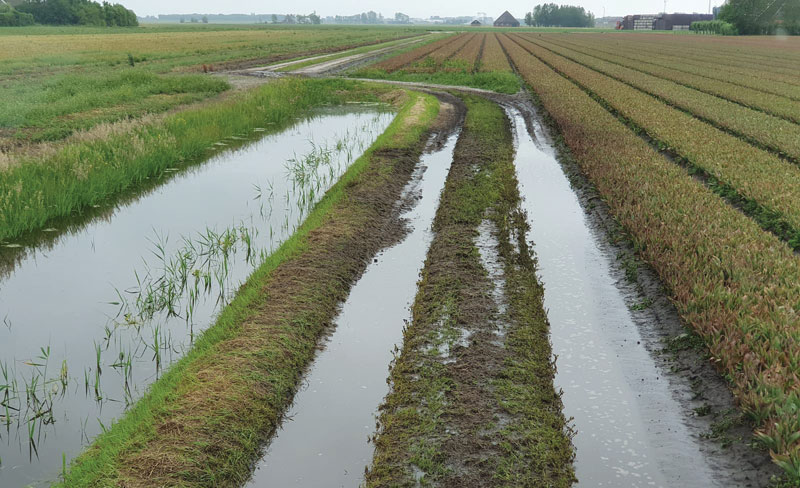11/1/2021
A “Choked” Bulb Supply
Jennifer Zurko
This past June, parts of the Netherlands saw record-breaking weather of 6 in. of rain within a matter of hours, flooding large areas of tulip bulb fields and leaving them sitting in water for days as growers frantically tried to pump the water into the canals.
“It’s very unusual to get that amount of rain so fast,” explained Dick den Breejen, Senior Advisor for Ednie Flower Bulbs’ Grower Support Team. “The Netherlands, of course, is very flat, below sea level, and they maintain that level through machinery in the bulb fields, keeping the water at a certain level so that the bulbs won’t be sitting in water, but the roots can still reach it. But because you’re already below sea level and you get this amount of intense rain in such a short period of time, the pumps just can’t handle it.”
After tulip bulbs are harvested, they go through an x-ray machine to make sure the inside is normal and disease-free. But most of the bulbs that were underwater after the June storms had to be tossed. As they were going through the x-ray, many of them had “choked” centers. (Dick said to think of a choked bulb like an egg with a rotten yolk—the outside looks fine, but the inside [the important part] is bad. The result of choked bulbs is you do get a stem, but no flower.)
Fortunately, most of the hyacinth bulbs were already being harvested before the storm came, but millions of tulip bulbs had to go on the compost pile, said Dick.
Bulb suppliers like Ednie were already planning for a bulb shortage because of the high demand stemming from the pandemic. Not only did we see more new gardeners in North America, but the Dutch had their fair share, too. And since almost 100% of the tulip bulb supply is produced exclusively in Holland, the growers there are growing more to meet the demand at home and exporting less.
The first disruptions from the pandemic happened in early spring 2020 when retailers chose food and toilet paper over cut flowers and potted plants, forcing growers to take back product and deal with order cancellations. Because of this, bulb growers cut 20% of their production for this year, meaning there was 20% less product planted in 2021, said Dick’s son Jeffrey and Ednie’s GM. You mix in significant delays in shipping and you’ve got three factors affecting the crop at the same time.
Tulips and Oriental/hybrid lilies had a rough go of it this year, but other bulb crops were able to have closer to a normal year. And, actually, Easter lilies, which are grown in California, have seen one of the best crops in over 10 years. Although parts of California experienced extreme heat and wildfires, the areas where Easter lilies are grown is protected by the micro-climate between the mountains on one side and the Pacific Ocean on the other, so they had a bumper crop this year.
As for other bulb crops, the folks at Ednie are in wait-and-see mode. Calla bulbs are expected to start their harvest at the end of this month, but Dick said they’re not too optimistic since they, along with dahlias, were also under water.
“It all traces back to that June rain, basically,” said Jeffrey. “The callas, dahlias and lilies—they still had a lot of time to grow, whereas the tulips were getting ready for harvest, so they had the most impact.”
So there is a shortage of tulip bulbs this year, but it all depends on what type you grow. If you produce the more traditional single colors, there’s likely to be substitutions available. But if you grow novelty colors or doubles, you’ll have a harder time finding subs. Jeffrey said it seemed that the novelties were the ones affected the most by the weather. So there will be tulip bulbs … just not all of the options you’re used to in a normal year.
“We have the total amount of bulbs that we need, it’s just that we have to do a certain amount of shifting,” said Dick. “For the greenhouse growers, they’re going to get the material. If you wait until the last minute to get the good deal … well, those deals will not be there.”
Which brings us to price. Dick and Jeffrey said that as growers build up their stock of tulip bulbs (which could take about two years) and shipping/freight costs continue to be high, expect prices to go up. To counter this, Dick is suggesting that all of their customers raise their prices at the retail level to counteract the higher input costs. It’s not like other goods and services aren’t experiencing the same thing, so we’re all feeling the pinch from every angle as businesses and consumers.
“Because Easter lilies from the West Coast involve a lot of labor, and labor costs have gone way up, Easter lilies have already gone through a dramatic price increase,” said Dick. “After we sweated it out, a majority of people have accepted it. So if that Easter lily was $5.99 at Walmart last year, they’re going to have to be $6.99. And that’s not a bad thing.
“In this industry, very sadly, we’ve been using flowers as loss leaders. Take the poinsettia. Take the garden mum. And it’s not the consumer. In past years, if you brought a 6-in. lily to the consumer, they would buy it. And if you bring a 12-in. for a lot more money, they will pay because it looks good. So it’s not the consumer—it’s what we bring to the consumer.” GT
